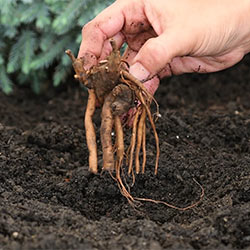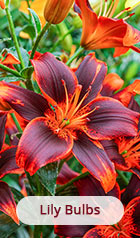
How to Care for Phlox
Want to add some local, native flair to your garden? Phlox flowers occur naturally in woodlands and prairies in North America, and are an excellent way to naturalize your garden. Grown in both spreading and upright varieties, phlox are an excellent plant for new gardeners due to their easy care needs. And, the plants' small flowers attract butterflies and hummingbirds.
Botanical Name:
Phlox
-
Tall Phlox or Phlox paniculata
-
Carpet Phlox or Phlox subulata
Most Popular Phlox Colors:
The most popular phlox colors include :
white,
pink, pale
blue, violet, and bright
red. These colors look fantastic mixed together, and phlox tends to be an excellent plant for pairing with other perennials. Try multi-colored phlox, too, and mix texture and shape with double-flowering varieties and both tall and creeping phlox.
Growing Phlox
When is the Blooming Season for Phlox?
In general, phlox flowers tend to bloom from late spring to early summer. Their foliage is among the first green foliage to appear in the garden, and goes a long way toward filling in between late-spring bulbs.
Soil Preferences:
Well-drained, enriched soil is best for phlox. These plants can handle a bit of drought, but don't like to have wet feet. Adding loam or compost to the soil can improve drainage.
What is The Best Climate for Phlox Plants?
Phlox grows in all temperate climates. These perennials can handle heat and cold, and are winter-hardy in Zones 4 through 8.
How Much Sun do Garden Phlox Need?
Phlox can take partial sun or full shade. Give your phlox at least four to six hours of sunlight per day.
Phlox Landscaping Tips:

Creeping phlox can be used as ground cover for your
perennial garden, or any type of garden, creating a bright carpet for the duration of the blooming season. The foliage of the plants is a vibrant green, creating good coverage before and after flowering. Really, you can't go wrong by choosing phlox for your garden.

Tall phlox plants like
Crème De La Crème and
Twisted Tall Phlox look excellent in the backs of flower beds. Consider planting them near other plants that are attractive to butterflies and hummingbirds to create a lush garden for fluttery friends. If you are looking to add more color and interest to your garden, check out our
Tall Phlox Mix Super Bag for a fun variety of phlox flowers.
Phlox Planting Guide:
Phlox are best planted in spring, and are usually shipped as potted plants. Plan to plant your phlox immediately upon receiving them, so that they don't dry out or become rootbound. Keep your plants' soil moist if you must wait to plant.
Before planting, choose the best possible location for your plants. Many phlox varieties are susceptible to mildew, and, like other perennials, they don't like consistently wet roots. Plant your plox in a sunny, airy location where water does not tend to pool. Be sure to check the spacing needs for your variety of phlox. Most creeping phlox should be planted 12 to 18 inches apart and grow only 6 inches tall. Tall phlox can grow upwards of three feet in height, so be sure to choose a site that allows for appropriate space in both width and height.
Before planting, prepare your soil. While phlox are amenable to many soil types, they'll do best in nutrient-rich, airy soil with good drainage. Till your area well, using a garden claw or hoe. Then, mix in topsoil or compost to add drainage and organic matter. Now, your phlox can be planted at the same depth to which they were potted.
Phlox Care Tips:
Phlox plants are considered one of the easiest to care for-they are low-maintenance, and typically only require watering. They do well with other plants and are not invasive. Follow our recommendations below on how to water, prune, and protect your phlox plants from pests and diseases.
Phlox Watering Recommendations
Keeping a well-watered soil for phlox plants is essential. If your garden receives less than one inch of water per week, it is recommended to water phlox plants regularly during the high-temperature months of the spring and summer. Watering should be done in the morning so that moisture can dry off during the day. Make sure to water your phlox plants at the root zone rather than overhead, to keep the foliage healthy.
Phlox Pests & Diseases Care
Phlox plants can be susceptible to pests such as powdery mildew, leaf spots, caterpillars, and leaf miners. The issue is more common in areas that have humid and warm summers, particularly with plants growing in part shade. The best way to prevent pest issues with phlox plants is to leave space between the plants to allow for good air circulation. Diseased plants should be regularly removed to prevent the spread of this issue.
Phlox Pruning Tips
Phlox plants don't require pruning, as the plants die back after each growing season. You can trim your phlox back to an inch or two of stem height after the first frost of the year.
Through the growing season, you shouldn't need to cut phlox. but you can cut them back as needed for desired shape and size. You may find that your creeping phlox need a trim if they are being used as border plants. You can trim any parts that are hanging on the sidewalk or the driveway. You can also cut the phlox plants to keep them in a neat form.
Phlox plants can be a great addition to any garden. Thanks to their low care needs, they're the perfect plant for any beginning gardener. But these aren't just hobbyist's plants. Phlox's reliability makes them a favorite of professional landscapers and experienced planters, too. Try phlox, and you'll quickly see why!
Have another question? Return to the Customer Service Help page or send an e-mail directly to Customer Service
























